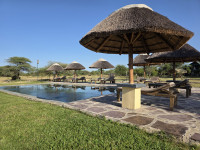
Arrival
Arrival

Day 1
Tarangire National Park
Tarangire National Park
The park runs along the line of the Tarangire River and is mainly made up of low-lying hills on the Great Rift Valley floor. Its natural vegetation mainly consists of Acacia woodland and giant African baobab trees, with huge swamp areas in the south. Both the river and the swamps act like a magnet for wild animals during Tanzania’s Dry season. The Tarangire National Park is reputed to contain some of the largest elephant herds in Africa. This African national park is also home to 3 rare species of animals – the greater kudu, the fringed-eared oryx, as well as ashy starlings. We eat lunch at the picnic site, then continue with the game drive until late evening and then drive to the lodge for overnight.
- Main Destination:
- Tarangire National Park
- Accommodation:
- Eileen's Trees Inn
- Meals & Drinks:

Day 2
Central Serengeti National Park
Central Serengeti National Park
After breakfast, you will travel via the cooler highlands towards the eastern Serengeti and at midday, you will reach the plains of the Serengeti National Park. This park is the largest in Tanzania and has a diversity of habitats and landscapes – short grass plains, savannah, thick bush, swamps and lakes. Bizarre rock formations called kopjes dot the grassy landscape where predators are often seen. The Serengeti is famous for the yearly migration when hundreds of thousands of wildebeests and zebras trek to find fresh grass and water.
- Main Destination:
- Central Serengeti National Park
- Accommodation:
- Africa Safari Serengeti Ikoma Camp
- Meals & Drinks:

Day 3
Northern Serengeti National Park
Northern Serengeti National Park
The entire day is dedicated to game viewing in the Serengeti. The areas that you visit will depend upon where the migrating herds are. Predators usually follow closely behind the trekking animals and include lions, leopards (in the acacia trees) and cheetahs. During the short rainy season in November and December, the herds move from the hills in the north to the plains in the south. During the longer rainy season from April to June, they return up north. As the migration is completely dependent on the yearly rainfalls, the location of the herds may vary from year to year but your guide will know where to locate the animals and where to see them best.
- Main Destination:
- Northern Serengeti National Park
- Accommodation:
- Kisura Serengeti Camp
- Meals & Drinks:

Day 4
Ngorongoro Crater
Ngorongoro Crater
The game drive today is on adventurous roads about 600 meters into the crater. The crater has a diameter of 17 to 21 kilometers and is the home of many animals. Nearly all the biodiversity of the East African savannah has gathered here. It is only giraffes and a few other animal species for which the rock faces are too steep, that do not live in the crater. Depending on the season, 15,000 to 25,000 animals gather here. Of these, more than two-thirds are buffaloes, gnus, zebras, and gazelles. The number of grazers in the crater also explains why the largest density of predators in Africa can be found here.
Besides other predators, more than 100 lions live here in several prides. The chances of seeing the "Big Five" (lion, elephant, buffalo, rhino, and leopard) within just a few hours are particularly good. In the afternoon, we ascend the steep crater walls and head to Arsuah/JRO.
- Main Destination:
- Ngorongoro Crater
- Accommodation:
- No accommodation (End of tour)
- Meals & Drinks:































